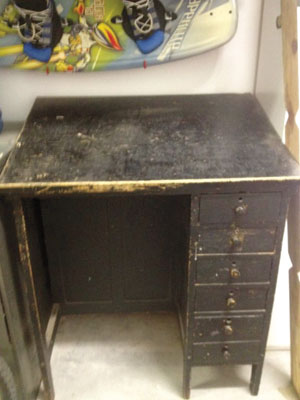
CB sends me a photograph of an old drafting table which intrigued me. This form of furniture isn’t designed for the uses of the body (eating, sleeping, sitting) but for a style of work. One can say designs for work are unique in themselves and, apart from the Eastern concept of beauty in work, they naturally lead to beautiful furniture design. The West never bought that philosophy. So furniture for work was never aesthetically pleasing, in Europe or America. In fact, just the opposite, designers left aesthetics for the home and the museum, not for the built workplace. Thus CB’s late 19th century possibly hand-crafted drafting table is a dog.
But what happened on such tables (drafting) built our modern world, for better or worse. Who knows when drawing split into two parts, drawing for beauty and drawing to build. From our earliest beginnings we drew, even on stone if that’s what we had. The line when drawn is a universal language. But here’s the catch, drawing split off into drafting and fine art when rational Enlightenment thinkers realized the property of drawing is at the very foundation of engineering.
A word about engineers, they’re responsible for technological advances. I myself know a lot about the engineering type, since my son’s father was one. So are my brothers, my uncles, my grandfather and all my male cousins. I’m the only artistic type in the family, and I both feared and hated math. I became an outcast. We had a drawing board in our basement, not an easel.
But, before I trash engineers, I realize that draftsmanship is an artwork sometimes. Drawing for the beauty of it, and drafting for the construction of it, are both really about creation. So before I argue this point using the same philosophy of dualism, art—non-art, let’s say engineers and their products are practical, they have ‘apps,’ and my drawings are anything but practical.
Engineering drafting which happened on this dog of a desk, controled the production of a commodity, which is perhaps why they first separated from “drawing” at the beginning of the Industrial Revolution. Drafting became the tool which led to the creation of the ultimate man-made world. Previous to the early 19th century, in architectural drafting, we knew about plan elevation and section, but nothing about how to draw these into the manufacturing mechanisms, the machines, themselves. Drafting of machines was the brainchild of Matthew Boulton and James Watt of Britain who drew engineering drawings of their steam engine factory in 1773.
CB, I’m not saying your desk harkens back to the 18th century. It’s in fact, a product of the 19th century, and has an Ohio River Valley origin. I can tell this by the simple lines in the late Sheraton style and round wood pulls, also the dour and depressing paint job which could be original. It’s not worth a lot, perhaps $500 at most. Unless, CB, you can show provenance, which means who used/owned it, and what miracle of engineering might have been produced on it. But this is only a long shot because when this desk was built (1840 – ) draftsmen had emerged as a separate labor class from engineers.
Draftsmen, or in England, draughtsmen, had little engineering or production skills, and since blueprints had not been invented, let alone the large format copy machines, they were employed as “delineators” or “copyists.” But, lest you think me a fine art snob, these copyists weren’t automatons, and often had tons of artistic skill. I love to see the old 19th century drawing of machinery. Since we are currently in a late Victorian Steampunk revival everywhere but Santa Barbara, these early mechanical plans are becoming hot property. It’s from the surreal quality of these drawings that the style evokes a disjunct between the machine age and Victorian Realism. Because on this very desk, CB, some lowly copyist would’ve shaded the sides of a square girder, or indicated shadow, to give the machine drawn an artistic sense of solidarity and reality.
These copyists worked on large-scale papers, and after inking the lines, hatching in the shading, they broke out their watercolors and tinted the machine drawings. Sometimes a little naturalistic element was thrown in, such as a little man working the lever of one of the these unreal machines, all proportionate and hand-colored. If the machine turned air or water, little mesmerizing representation of wave lines colored blue might appear. Thus, CB, your desk was a crucible for some engineered elegance, rational surrealism, and perhaps the 1840 birthplace of what we now call Steampunk style. Still, it sure is homely.